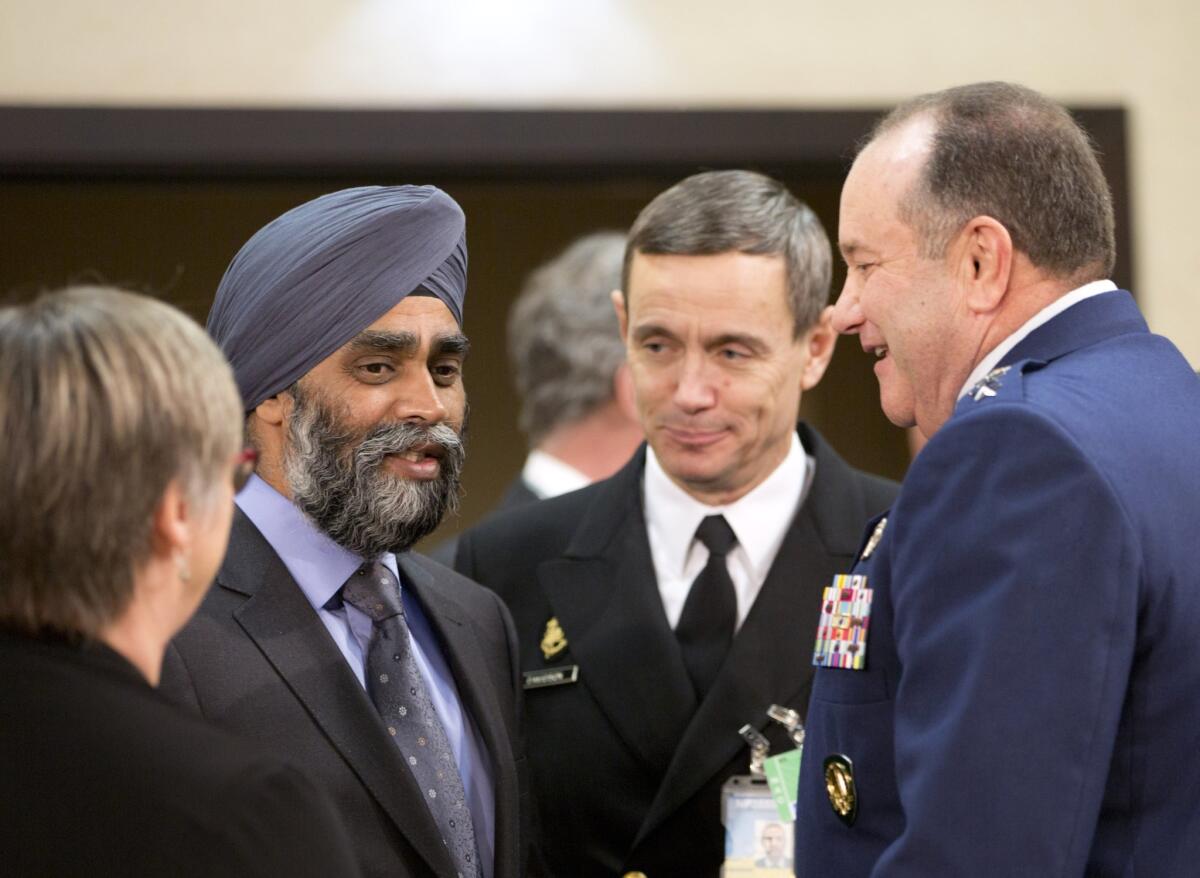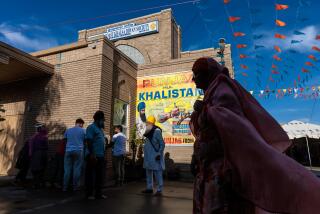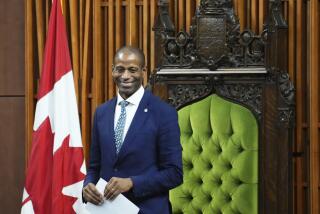Defense Minister Harjit Singh Sajjan: A Sikh soldier’s climb to the Canadian Cabinet

Canadian Defense Minister Harjit Singh Sajjan speaks with U.S. Gen. Philip Breedlove, supreme allied commander in Europe, right, during a meeting of the North Atlantic Council at NATO headquarters in Brussels.
- Share via
reporting from OTTAWA — Three months ago, most Canadians had never heard of Harjit Singh Sajjan.
But after newly elected Prime Minister Justin Trudeau tapped him to be defense minister in November, a 2006 photograph of the former soldier went viral on the Internet.
It shows him on duty in Afghanistan, wearing a wide smile, bushy beard, camouflage flak jacket and wraparound sunglasses. But it was his head wear that attracted the most attention: a turban.
Sajjan is a Sikh immigrant from India. His appointment to the Cabinet is a testament to Trudeau’s willingness to break tradition. The first person of color to run Canada’s 100,000-person defense department and military, the 45-year-old former police detective is neither a career officer nor defense policy wonk.
See more of our top stories on Facebook >>
Until Sajjan was elected to Parliament last fall, he had never been a politician either.
Now he is the point person in implementing Trudeau’s campaign promise to end Canada’s fighter jet bombing operations against Islamic State militants. Sajjan announced the move this month.
In an earlier interview with The Times, he explained: “We are going to be adjusting our resources to have a greater and meaningful impact on the mission and meet the needs of the coalition.”
For the most part, Canadians have welcomed Sajjan’s appointment. “Badass” became the standard description on social media. One military officer was reprimanded for posting racist comments on the Canadian forces Facebook page.
Sikhs in Canada number about 500,000 — or just over 1% of the country’s population — though their turbans, beards and gravitation toward politics and activism have made them more visible than many other minorities.
They now occupy four of 30 positions in Trudeau’s Cabinet.
Born in a farming village in the state of Punjab, Sajjan was a beneficiary of Canadian immigration reform under Trudeau’s father, then-Prime Minister Pierre Trudeau, that encouraged family reunification. Sajjan arrived in Vancouver as a 5-year-old with his mother and sister to join his father, a former police constable who had immigrated a few years earlier and worked in a sawmill.
He grew up in South Vancouver, an immigrant enclave with a large Sikh population.
After graduating from high school in 1989, Sajjan joined the reserves and immediately encountered cultural conflict. The Sikh religion, a monotheistic faith that originated in the 15th century, generally requires its adherents to keep their hair uncut and wrapped in a turban. Because that made it impossible to wear a standard gas mask, Sajjan invented and later patented a protective hood that solved the problem.
His first deployment overseas was a North Atlantic Treaty Organization peacekeeping mission to Bosnia-Herzegovina in 1997.
Two years later, the soft-spoken Sajjan joined the Vancouver Police Department as a patrol officer and was eventually promoted to a plainclothes detective in the gang unit.
He would encounter buddies from his old neighborhood, which was a hotbed of gang activity.
“I was sometimes arresting people who were more physically fit and smarter than me,” he recalled. “It was sad to see them end up this way.”
His unlikely rise to the top defense job started with a 2006 leave of absence from the police department to deploy to Afghanistan as a reservist.
It was during that operation that Sajjan posed for the now-famous photograph.
Sajjan was originally sent to Afghanistan as an administrative officer. But his Canadian commander, Maj. Gen. David Fraser, had other plans for him.
In Fraser’s estimation, the Taliban was nothing more than a criminal organization, and who better to gather intelligence on a criminal organization than a police detective? “Harj’s name came up as a cop who’s a reservist,” Fraser said.
He made Sajjan his liaison to Kandahar’s governor, which opened access to a wide range of people. It helped that Sajjan spoke Punjabi, which is similar to a dialect spoken in Kandahar, and that the Afghans could identify with the oppression Sikhs had long endured.
Sajjan immersed himself in the community, “like a cop walking the beat,” Fraser said.
Sajjan focused on the U.S.-led coalition’s strategy of keeping young Afghan men out of the Taliban by offering them jobs. “Money was a huge part of the Taliban’s recruitment of fighters, so we out-hired them and gave Afghans jobs for existing projects, such as helping to build irrigation canals,” he explained.
He said he found it “surreal” to be in Afghanistan, a country where 21 Sikh soldiers fought to the death more than century earlier to protect a British army post under attack from 10,000 Pashtuns.
The battle cemented the reputation of Sikhs as warriors.
Sajjan was cementing his own reputation as an intelligence asset.
In 2010, he was back in Afghanistan when U.S. Army Lt. Gen. James Terry, commander of the famed 10th Mountain Division, asked him to join the unit as a special advisor.
Sajjan resigned from the Vancouver police to take the job.
“I couldn’t get another leave of absence, so I quit,” Sajjan said. “People thought I was nuts because I would lose my pension. But the reason I joined the military was to serve, so how could I walk away from this?”
He said he also understood the symbolic importance of a Sikh in such a position. “Here a senior commander of one of the most famous divisions in the U.S. military asked for me by name to come work for him,” he said.
Back in Canada in 2011, Sajjan became the first Sikh to command a Canadian reserve regiment.
Politics was never in his plans, until Trudeau recruited him to seek the nomination as the Liberal Party’s candidate for Parliament in the Vancouver district where Sajjan had grown up.
“I’m a good judge of character from my work as a detective, and saw that he wants to make a difference — and so do I,” explained Sajjan, who is married to a doctor and has two small children.
In the October election that swept Trudeau and his party to power, Sajjan captured nearly 50% of the votes to defeat the incumbent Conservative.
Sajjan said he was as surprised as everybody else when Trudeau asked him to be defense minister.
In 2015, Canadian CF-18 jets dropped more than 500 bombs on Islamic State targets, primarily in Iraq. The jets will be pulled from combat this month. At the same time, Canada will increase the number of special forces training Kurdish fighters in northern Iraq from 69 to more than 200.
Sajjan said the new approach places a greater emphasis on intelligence gathering than combat.
The shift is not without critics, including Sajjan’s old mentor, Fraser, now retired from the military. He said he believes Canada should continue with its bombing mission to maintain the momentum by the Kurdish, Iraqi and Syrian forces that has placed Islamic State militants on the defensive.
Though Fraser favors defense ministers without military backgrounds, he said he believes that Sajjan possesses “sincerity, intelligence and commitment” that will serve him well.
Sajjan said he hopes his years in uniform will help motivate the troops, and maybe Canadians in general. His photograph from Afghanistan continues to be shared on social media.
“If someone looks at that image and thinks, ‘Wow, if this guy can do this stuff, I can too,’ then I’ve inspired people along the way, which has always been my goal,” he said. “But it is just a picture, and life has a way of humbling you if you have any type of arrogance.”
Guly is a special correspondent.
ALSO
Islamic State frees Syrian Christians held since 2015 for ransom
A fast growing club: Countries that use drones for killing by remote control
Murder, torture, drugs: Cartel kingpin’s wife says that’s not the ‘El Chapo’ she knows
More to Read
Sign up for Essential California
The most important California stories and recommendations in your inbox every morning.
You may occasionally receive promotional content from the Los Angeles Times.










